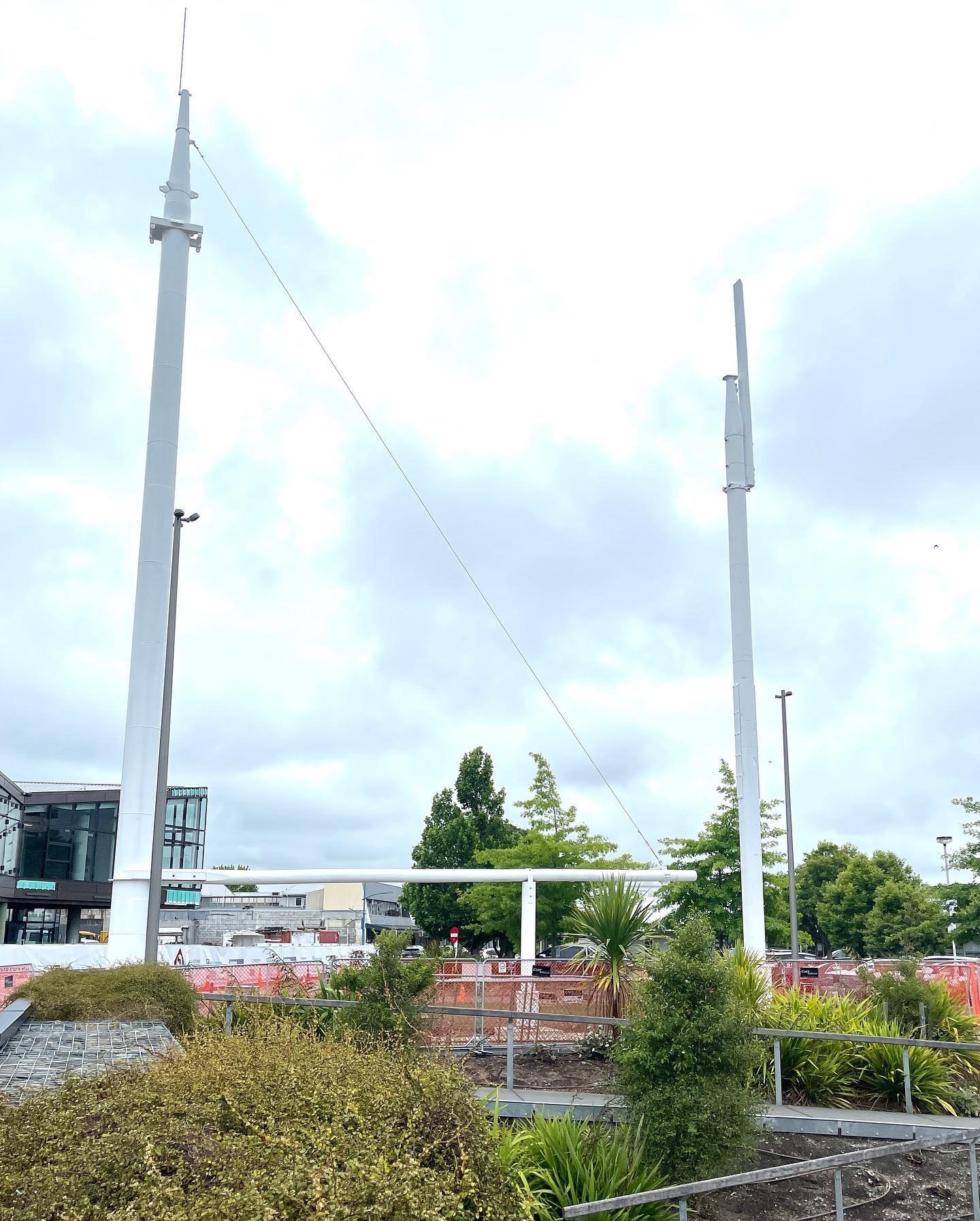Heritage - The Quays, Riverside Park
This location has great historical significance for Blenheim, as an early port for boat passage and trading. These masts and the Library are on the site of the first wharf, wharf shed and hotel of the trader James Wynen. As you look out towards the river today it can be hard to imagine the days when schooners, scows and steamers moored here to load and unload their cargo and passengers, after weathering the elements of Cook Strait.
Background information on the Heritage site
Shipping and trade on the Ōpaoa River
In the early days of European settlement, coastal and river trade was essential to our developing Province. Until 1859, Marlborough was part of Nelson Province, and Blenheim had previous names including Waiharakeke, The Beaver, Beaver Station and Beaverton.
Blenheim’s shipping trade dates back to 1849 when small coasters such as the Triumph and Old Jack discharged and loaded cargo inside the Wairau River Bar. Marlborough goods were ferried across the Wairau Bar to larger vessels waiting in Te Koko-o-Kupe (Cloudy Bay) or at Te Whanganui (Port Underwood) and goods were transported to Blenheim in whaleboats towed by horses walking along the North riverbank.
Following major earthquakes in 1848 and 1855, the Lower Plain subsided, and the rivers became deeper, allowing goods and passenger transport directly from Blenheim to Wellington by ship.
There was keen competition for the Cook Strait trade, and within a few years several small trading ships were sailing between Blenheim, Wellington, Nelson and Wanganui. In 1862, the Nelson and Marlborough Steam Navigation Company began trading across Cook Strait with an 84-ton paddle steamer the Tasmanian Maid, followed by the P.S.Lyttelton, which was the first steam ship to reach Blenheim in November 1862.
Captain Thomas Eckford entered the scene in 1881 with the 30-ton steamer Mohaka, and eventually the Eckford Shipping Company outlasted earlier competitors such as The Wairau Steamship Company, The Union Steamship Company and the Anchor Shipping Company. Eckford ships included Neptune, Opawa, Wairau, Omaka and Kohi, but the most renowned of all was the auxiliary scow Echo.
The A.S Echo
One of New Zealand’s sturdiest and finest scows.
The Echo was built in 1905 by William Brown & Sons at Northern Wairoa, using the highest quality kauri and totora timber. The 104-foot scow, had a flat bottom, two centre boards and was rigged as a topsail schooner with a small berthing engine being its only other source of power.
Originally built for the Kaipara timber trade, but also used for coal, she later sailed between Wellington and Karamea, and then carried meat from Wairoa to Napier.
In 1920 she was bought by Charles Eckford and her 45 years based at Blenheim began. Crossing Cook Strait approximately 15,000 times, the Echo carried all sorts of cargo from cars to fruit, with the ability to carry up to 125 tonnes. The ship with 10 crew often made six crossings per week, taking about 12 hours between Blenheim and Wellington.
Adventures on the Ōpaoa
After crossing the hazardous Wairau Bar, the Echo was particularly famous for the way she worked her way up the narrow and meandering Ōpaoa River to reach Blenheim. Some of the twists and turns were too tight for the ship’s turning circle, and she was purposely steered into the side of the river, striking the outside bank so that the bow would bump around the bends.
Added to this was the poor visibility caused by the many willows that lined the banks of the Ōpaoa, often spreading their branches to meet right across the river forcing the ship to push through the foliage. As the tall masts forged their way through the greenery the ship’s crew stayed well under cover as large branches were dislodged and crashed to the deck. The ships usually arrived, in either Blenheim or Wellington, covered in willow branches torn from the trees during their passing.
During her seagoing days, Echo foundered twice, was stranded at least fifteen times and damaged at least as often. She suffered three fires and seven collisions, one with an outhouse on the Ōpaoa riverbank.
The Life and times of the Echo – a brief summary.
1905 – Built by William Brown & Sons, Northern Wairoa for the Karamea Steamship Co.
1916 – Bought by Richardson’s of Napier to transport frozen meat from Wairoa.
1920 – Eckford & Co bought her for their Blenheim to Wellington freight run, removing the topsail and installing two large diesel engines.
1942 – Requisitioned by the Government for wartime service in the Pacific Islands.
1944 – Returned to Eckford & Co to resume regular sailings to Wellington.
1960’s – Growing competition from Picton and Lyttelton led to a further reduction in sails and more powerful engines being installed to increase her maximum speed to 8 knots
1965 – Unable to compete with the newly introduced Picton to Wellington ferry Aramoana, the Echo made her final trip across Cook Strait.
1972 – The Marlborough Cruising Club bought the Echo and towed her to Picton to be used as their club rooms.
1992 – Tim & Denise Dare bought the Echo and began some restoration work.
2004 – The Echo was converted to a café and restaurant.
2014 – The deterioration of the Echo, and concerns over public safety, led to her being purchased by Port Marlborough.
2015 – After being declared unsafe and beyond repair, the Echo was demolished. Valuable historical items were salvaged from the ship, including the masts which are now located here at The Quays Park.
2022 – These masts, boom, and history of the Echo, were opened to remind us of over 160 years of commercial shipping on these rivers.

